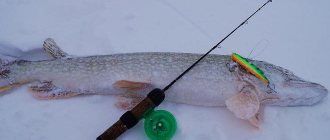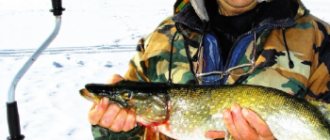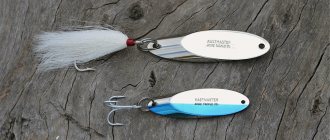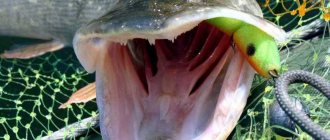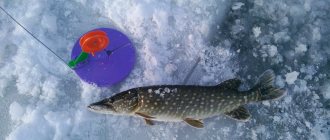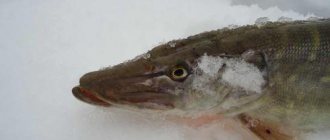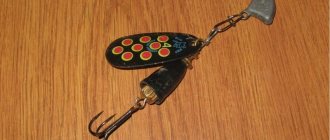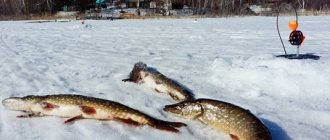How to catch pike in summer on small rivers with spinning rods and mugs. Features of small rivers, nuances of gear, suitable baits. Fishing tactics on these difficult bodies of water.
My friends and I often practice catching pike from a boat with a spinning rod and mugs, finding interest and practical use in this active fishing. Favorite places are small rivers. Typically, such reservoirs are actively overgrown in the summer; there are many snags along many sections, so there is little fishing pressure, which is what we like.
The places are so difficult for spinning, and the pike is so shy that, in principle, it was possible to get by with live bait gear alone, which brings the lion’s share of catches. But spinning sometimes helps out, especially at the end of summer - beginning of autumn, when pikes begin to leave the thinning grass and go to the pits. And anyway, how can you go after a predator without a spinning rod?! It’s more fun with him, it’s warmer on rainy damp days, and your hands are always busy. Although, to be honest, when the mugs work with a bang, there is no time for spinning.
In general, if you are “out for fish”, then you can get by with “cans” alone. We call mugs banks. And if “for fishing” you want more aesthetics, movement, there is a desire to find yourself a complex spinning problem and solve it successfully, or just have fun catching perch, then you can’t do without a spinning rod on a small river.
Pike places on small rivers
The main problem is not that fishing for pike with a spinning rod on small rivers is complicated by the fact that the predator reacts worse to artificial baits, but the often insurmountable technical and tactical difficulties for this method of fishing. After all, for the most part, large pike stick to places that cannot be fished from a more or less distant distance. And when you get closer, when you can act for sure, there is a huge chance of spooking the fish, and it will no longer take the most beautiful bait; this is often even visible to the eye - it moves away to the side and was like that.
With live bait, the tactics themselves are radically different - they swam up, put the crucian carp into a suitable pike “hole” and swam away. Even if a predator was standing nearby and was alerted, it will not go far, will soon calm down and return to the baitfish, cutting circles. This is the only advantage over spinning, but it is significant in the fishing conditions offered to the fisherman by the “cunning” small river.
But if the pike does not see the fisherman, then it is not afraid of anything. There was a very significant case recently. When fishing with a circle, the pike seemed to be hooked reliably, but in the process of fishing it went away - the hook broke. I replaced the live bait with a fresh one, and after half an hour the bite started again. Is there a flock of pike standing here? No, I take it out, and a broken hook sticks out in her mouth - it’s mine, I won’t confuse it with someone else’s.
The most typical places where pike take are not so diverse
A fairly dense pitcher plant works reliably, where the predator is most common. One experienced fisherman once told us: “If you saw water lilies, put a circle, you won’t be mistaken, pike always lives in water lilies.” You’re unlikely to hook a large one, but a medium-sized one is no problem. True, there is one peculiarity - the water lilies are full of pike when the water is not very clear. If the bottom is visible at a depth of a meter, then the toothy one leaves the water lily, both in summer and in autumn, moving closer to the snag, to the dumps of the pits. But clear water in small rivers in summer is quite a rarity, I complain a little about this, since I also like to dive, seeing with my own eyes that even with underwater visibility of a meter there are very few pike in the water lilies, mostly outright trifles.
Snag holes are also always promising for fishing; at the end of summer, when the water gets colder, they become even more densely clogged with pike. Moreover, the relationship is direct - the denser the snag and higher above the bottom, the more toothy it is and the greater the chance of catching a solid trophy. Often on small rivers there is such dense snag that it is absolutely impossible to fish directly in it. Then fishing on cans with placing live bait next to a snag, on a clean bottom, as long as there is no strong current here, it is desirable that there is some kind of lull present, the return, and the toothy one comes out of its den, reacting to the live bait.
It is better to ignore smooth, shallow runs, especially with a strong current - you can only run into a normal pike here by accident during its local migrations, and the small “grass” under the coastal grass is uninteresting. Entrances to oxbow lakes are very promising. Quiet coastal barrels under trees bent over the water, where you can also be exposed if the depths reach at least half a meter, and the slow-moving fish borders on a fast current.
And more about places with an eye to the season
It has been noted that in the hot summer the bite is usually worse, but specific places work stably. At the end of summer, the pike's appetite intensifies, but places begin to wander - the toothy one cannot sit still. I notice this thing as a submariner - it’s at the end of August, when the best chances are to wait for clear water, one day somewhere on the point and there are plenty of fry and pike, and I’ll come in a week, and even if the ball rolls, not a small thing, not a predator can not see. Although nothing has changed in nature - the temperature is stable, the atmospheric pressure is even. So at the end of summer - beginning of autumn, it makes sense to rearrange the live baits and work wider with the spinning rod, which I don’t see the need for in the height of summer. Otherwise, late summer catches may be worse than early summer ones, although the feeding activity and aggression of pike is higher in late summer and autumn.
Pike of small reservoirs
This voracious, cunning, but cautious predator can be caught at any time of the year. But unsuccessful pike fishing in the summer leads to the fact that some fishermen completely forget about it in the fall. But in vain they do this. You can also hunt for pike in the fall, and it’s not bad at all. You just need to know where exactly to do it and avoid the mistakes that some people often make.
In late autumn, as usual, inclement weather sets in. Catching pike from the lady's boat becomes impossible. It is also impossible to catch it from the shores of large bodies of water; you simply cannot get it. The water becomes colder at this time. For this reason, floating green plants die off, larger representatives of aquatic flora will dry out and the water will become more transparent. In such reservoirs, in shallow water, in water saturated with oxygen, the predator loves to be at this time.
This is especially typical for reservoirs where a sufficient number of different species of fish live. It is in such shallow, small-sized bodies of water that this predator should be hunted in late autumn.
However, many believe that only bee-eaters are found in such small bodies of water, and there have never been any traces of large specimens here. This is an absolute statement that does not deserve any discussion.
Signs of the presence of large individuals
Based on a number of characteristic features, we can conclude that it is here that there is an opportunity to get a large trophy.
- 1. The reservoir is very rich in natural live food for pike. There are many perches and other fish species.
- 2. The average weight of caught specimens of squints approaches five hundred grams.
- 3. In winter, this body of water almost never freezes completely to the bottom.
- 4.Test marks from the teeth of caught squint or other fish, more than ten centimeters.
- 5. The presence of schools of perches of different numbers, very active in their behavior.
Small active perches always attract pike, because it is the perch that is the predator’s favorite treat. Pike are certainly not as active in feeding as perch. She has long intervals between meals. She needs to digest large prey, and this takes time. But when she gets hungry, she goes hunting. In response to this, the perches seem to become quiet and the bites stop. This is a signal to the fisherman that there is a pike somewhere nearby.
Also interesting: Common pike
Practice shows that quite often decent specimens of Her Majesty’s pike are caught in small rather than large reservoirs. This is understandable, because logically the probability that bait on a small lake will be found in its immediate vicinity is much higher than, say, on a huge reservoir. The bait is in one place, and the pike is a kilometer away from it. Catching this predatory representative in small reservoirs has its own nuances.
At the same time, fishermen often make the same typical mistakes
- 1. The size of the bait is too small. Considering that there are no large specimens here, the fisherman also uses a small-sized spoon. The golden rule says that the ideal bait is one that is commensurate with the fish that the pike feeds on, and for a predator this is neither more nor less, but ten percent of the mass.
- 2. Having made unsuccessful attempts to catch pike in hot weather in the summer, many anglers generally put spinning on the back burner. All this, of course, is in vain. After all, it is on small bodies of water in the fall that she feels freedom, harmoniously combined with her predatory nature. Hunting for predators here is not only possible, but also necessary.
- 3.Frequent use of artificial bait. In small bodies of water, the predator is deprived of the opportunity to frequently swallow live bait. But she needs to grow. We must learn to use live fish more often when catching this predator.
- 4. Sometimes the fisherman simply does not have enough endurance and patience. The specificity of small-sized reservoirs suggests that for a short time, they, as they say, pass along and across it. There is no bite, no trophy and the fisherman simply leaves, concluding that fishing here is useless. But this is done in vain. You have to stay and continue fishing and luck will certainly smile.
The fisherman left, and the cunning pike sits in the water and laughs at him. Practical experience in catching this predator shows that, despite the fact that there was not even a single bite during the day, it is highly likely that it will bite in the evening. We should not forget that pike do not feed every hour, or even every day.
Also interesting: Catching pike with a jig
Having made a throw once and caught a large prey, it will digest it for a long time. But when she gets hungry again, the chances of catching her will increase enormously. Then the next time you come to a pond, even if it seems too shallow, small and unsuitable for pike to live in, you must make every effort to prove the opposite.
You can look for one or another body of water for the upcoming autumn fishing for large predators by simply asking the fishermen living here who prefer fishing with a regular float rod. It is worth asking them in detail which fish are mainly found in it. Has it become less over the last, say, year, or, on the contrary, has its quantity increased?
If the roach or sleeper has become larger, but their number has decreased, this means that the pond has been populated by pike and perch. In addition, you need to ask if the caught specimens have any characteristic marks. If the number of such fish has increased, i.e. Since they are actively breeding, it is useless to catch pike here, it is simply not here. Of course, rare individuals may appear with the introduction of waterfowl eggs, but the cramped conditions of a small reservoir do not allow them to reproduce properly.
An amazing feature of this far from stupid predator is that it has an excellent art of camouflage. Provided the water is fairly transparent, it is not always possible to see it. But this does not mean that the pike cannot be visually detected at all.
During the spawning period, the predator, in the heat of the excitement of love games, often splashes out of the water. Thus, you can clearly see what kind of trophy you will eventually catch, which will be a specific reason for the fisherman’s pride.
Features of snap-ins
In most cases, fishing with circles on small rivers by free swimming is unpromising. It is much more profitable to anchor the tackle with a small end weight the size of a teaspoon. The basis of the design does not matter what - a piece of polystyrene foam, a plastic bottle or a classic circle. The diameter of the fishing line is also not so important - it makes no difference to the pike. But the length of the fishing line is very important. When fishing at any depth, be it a meter or four, you need to have a reserve of ten meters, because a toothy tackle can drag it anywhere - into thick grass, into snags, and you need a supply of fishing line so that the can remains on the surface of the water in any case, otherwise You can lose both the tackle and the fish, which will die in vain. Yes, and not only people can steal a jar. There was a case when they set up gear and went higher with spinning rods. We come back - one can is missing! And she is nowhere to be seen in the water area! Is there really a giant pike on a small river, and it was she who dragged the tackle to God knows where?! And then they noticed her on the shore - the water rats grabbed her and pulled her to the shore...
Side metal leash of 50 cm - I connect two cheap green store-bought leashes of 25 cm each through loops, they are strong, you can safely pull out the pike. I fix the leash on the fishing line as usual - with a stopper, moving it up and down. The stopper should not be too rigid, but when hooking, it should move towards the load, making it possible to hook the pike as reliably as possible. But this is if you hurried to work. Because I use a double and the classic “swallow” bait: I insert the leash into the gill of the baitfish, bring it out through the mouth, hook the hook, pull it back, the forend of the double hides in the mouth, only the hooks stick out. With this method of baiting, there is no particular need to hook, but only when you are not in a hurry to work, but let the pike reliably swallow it.
When we tie a can to coastal branches in a current, again not strong, but noticeable, then I use a different rig, similar to the rig - with an end hook, and the load is located higher. Although there are no problems anchoring live bait gear everywhere.
Suitable live bait
Usually we don’t really rack our brains and fish for imported crucian carp, trying to pick up a larger fry, at least 10-11 cm. It’s reckless to fish for small baitfish on a small river - an unqualified pike can be tormented, and, unlike spinning fishing, it is usually , you won’t let go “alive and undamaged,” as the toothy small fish swallows deeply. So we don’t spoil the fish, this has already come with experience. Large live bait eliminates small pike - it can grab, but does not swallow, but simply knocks down or cuts crucian carp. If there is no supply of live bait, then right on the river there is no problem catching white fry with a fishing rod. There are no problems especially with bleak - in any place where the current is a little calm, stand and catch as much as you need.
Features of fishing in spring
Spring fishing has its own nuances. Usually, pike go out to spawn after the ice has melted and the water has warmed up to a temperature of +4 to +9°C. You can’t count on a good catch during spawning: the fish are sluggish and passive. But immediately after spawning, the golden time for fishermen begins - the spring zhor. During this period, the “spotted” one grabs any bait without thinking.
Pike bite consistently well in May. In low-water rivers, by this time the water is well warmed by the sun, and small fish, its main food, are active and playful.
Spring pike goes hunting and attacks various baits. Usually it stands in shallow water, waiting for prey that goes to spawn.
About
Fishing for pike with a spinning rod on small rivers
Here, too, everything is simple, because the rather difficult conditions of small rivers do not stimulate any spinning delights. Here it is important to simply fish quickly and as accurately as possible, having learned to accurately handle compact points. Accordingly, jig is unrivaled, both with open hooks and with offset ones - depending on the situation in specific places. The most popular bait on our small river is a white ripper with a red tail 6-8 cm long; we mostly fish with it, considering it universal throughout the season. But different loads may be required. The maximum that may be needed is 18-22 g when fishing holes with a complex bottom. The minimum for pike fishing is 7 g. Lighter ones are better suited for catching perch with small rubber.
Spinning fishing
Photo 2. On a small river and after the first snow it bites on a spinning rod.
Fishing for pike with a spinning rod on small rivers is the most common and widespread activity. In addition, catching a toothy predator with artificial bait is extremely interesting, not boring and rewarding. This direction of fishing in relation to reservoirs of the type under consideration has a number of distinctive features that affect the layout of gear and the selection of suitable baits.
Beginner fishermen should initially acquire a universal kit that is suitable for most baits and various fishing techniques:
- The rod is about 2.10 meters long, weighs up to 20 grams, has a medium-fast action.
- Reel size 2000–3000, inertia-free, universal with a reduction of about 5.0:1, with good line laying and easy movement.
- Braided cord and monofilament line with breaking load up to 4–6 kg.
It is optimal to get a reel with several spare spools. One must be wound with monofilament. It is useful when fishing with rotating spoons. This type of lure spins the line a lot. This leads to rapid damage and tangling of the cord. Therefore, it is better to use inexpensive and less prone to torsion nylon.
Pike baits for small rivers do not differ from those used in other types of reservoirs. Depending on the time of year, the preferences of the predator change, which must be taken into account when selecting the optimal set of catching spoons and wobblers.
In spring and autumn, the first place is occupied by various silicone baits. They are the most effective because they allow you to carefully fish promising points and shelters. The best results are shown by banal vibrotails and twisters, which can be equipped either with a hinge or on classic jig heads.
With warming, other types of baits begin to work more confidently. The main ones are:
Photo 3. Popper class wobbler.
These baits turn out to be the most versatile and work all summer, showing consistent results. It is also worth paying attention to crankbaits, non-snagging spoons, walkers and spinnerbaits. For small rivers, it is advisable to choose an average size within 7–10 cm.
Photo 4. Pike spoons.
Walk on water
The small river has a narrow channel, but there is still a current and it is not easy to row over significant distances. At one time they went with an electric motor - it is unreliable if there is no spare battery, and you will have to take up the oars again. A low-power gasoline engine is perfect for frequent trips along the river. We have a “five”, which, if necessary, even allows you to go out on a glider in a 2.9 m boat. By the way, it can be useful to “throttle” near the exposed circles; this technique often activates the pike bite.
In fact, small rivers are not easy, so to speak, for an amateur, and they have not gained much popularity among domestic fishermen. But still, some people, on the contrary, like them. And everyone finds what they like best. Our company is drawn to wild places, where the banks are muddy, there are practically no approaches, and therefore there are no people either, and the small river provides us with such an opportunity, for which we thank it very much!
In the backwaters for perch
Catching fish with a fly and grasshopper
Features of the Finnish hook
